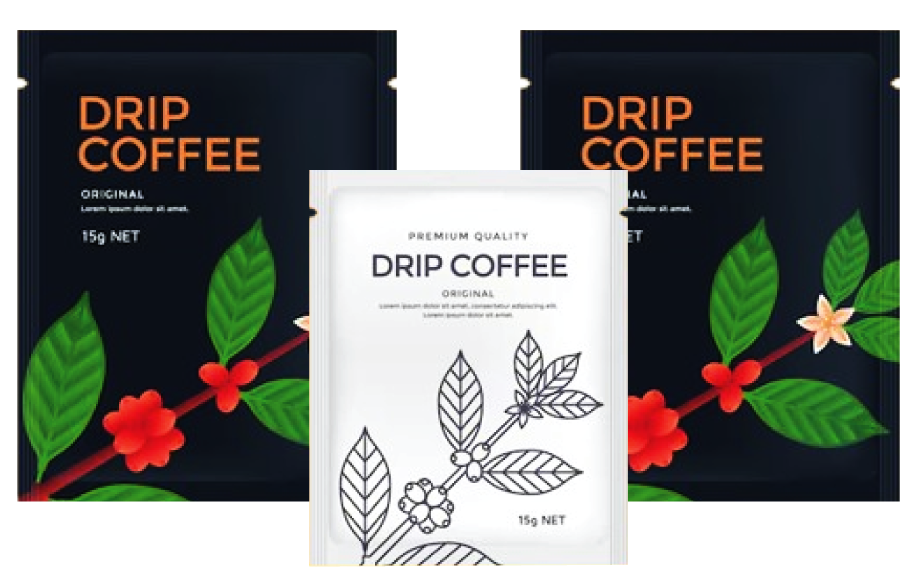Drip Coffee Bag Packaging has revolutionized the way coffee lovers enjoy their daily brew. These convenient, single-serve coffee bags are gaining popularity for their ease of use, portability, and ability to deliver a high-quality coffee experience without the need for complex brewing equipment. However, the success of drip coffee bags is not just about the coffee itself but also the packaging.
1. Materials Used in Drip Coffee Bag Packaging
The choice of materials for it is paramount. Coffee is a delicate product that is highly sensitive to air, moisture, light, and temperature, all of which can compromise its flavour and aroma.
- Multi-Layer Laminates:
Most drip coffee bags are made from multi-layer laminates, which combine different materials to offer superior protection. These laminates often include layers of polyester (PET) for strength, aluminium foil for a moisture and oxygen barrier, and polyethylene (PE) for heat-sealability.
- Paper and Non-Woven Fabrics:
The inner bag that holds the ground coffee is typically made from food-grade paper or non-woven fabric. These materials allow water to permeate and extract the coffee while retaining the grounds inside the bag.
- Sustainable Alternatives:
With growing environmental concerns, there is a shift towards using biodegradable or compostable materials in drip coffee bag packaging. Materials like polylactic acid (PLA), derived from renewable resources like corn starch, are being used as alternatives to conventional plastics.
2. Design Considerations
Packaging design is not just about aesthetics; it also involves functionality, convenience, and user experience. The design must consider the end-user’s needs, the brewing process, and the overall brand image.
- Ease of Use:
One of the key selling points of drip coffee bags is their convenience. The packaging should be easy to open, and the coffee bag should be simple to place over a cup or mug. The design of the bag, including the hooks or arms that secure it to the cup, must be sturdy yet flexible.
- Portion Control and Consistency:
Each drip coffee bag is pre-portioned to deliver a consistent coffee experience. The packaging should ensure that the right amount of coffee is used in each bag, with clear instructions for brewing.
- Branding and Aesthetics:
The visual design of the packaging is crucial in attracting consumers. It should reflect the brand’s identity, whether that’s luxury, artisanal, or eco-friendly. The use of colors, fonts, and imagery should align with the brand’s message and target audience.
- Informational Content:
Packaging should also provide essential information, such as the coffee’s origin, roast level, flavour profile, and brewing instructions. This not only educates the consumer but also enhances the perceived value of the product.
3. Branding and Marketing through Packaging
Packaging is a powerful tool for branding and marketing. It’s often the first point of contact between the consumer and the product, making it a critical component in the customer’s decision-making process.
- Differentiation:
In a crowded market, distinctive packaging can set a brand apart. Unique shapes, colors, or materials can catch the eye and make a product stand out on the shelf. For example, a drip coffee bag brand might use vibrant colors to differentiate itself from competitors or opt for an unusual packaging shape that reflects the brand’s innovative spirit.
- Storytelling:
The packaging is also a medium for storytelling. Brands can use it to convey their values, mission, and the story behind their coffee. This might include information about the coffee’s origin, the farmers who grew it, and the sustainable practices used in its production.
- Premiumization:
For premium coffee brands, packaging can enhance the perceived value of the product. High-quality materials, elegant design, and attention to detail can communicate luxury and justify a higher price point.
Conclusion
Drip coffee bag packaging is a crucial element in delivering a high-quality coffee experience. From the choice of materials to the design, branding, and sustainability considerations, every aspect of the packaging plays a role in the product’s success. Canadian Packaging Companies are leading the way in innovative and sustainable solutions for various industries, including food and beverage, cosmetics, and pharmaceuticals.
FAQs
What materials are commonly used?
Multi-layer laminates, paper, and non-woven fabrics are commonly used for durability and freshness.
How does it maintain coffee freshness?
The packaging uses airtight, moisture-resistant layers, often including aluminium, to protect the coffee from oxygen and light.
Is it recyclable or biodegradable?
Some are recyclable or made from biodegradable materials, depending on the brand and material used.
Can I customize the design of it?
Yes, many brands offer customizable packaging options for branding or personal preferences.
What makes it eco-friendly?
Eco-friendly packaging uses sustainable materials like biodegradable films, reduces waste, and is often recyclable.



